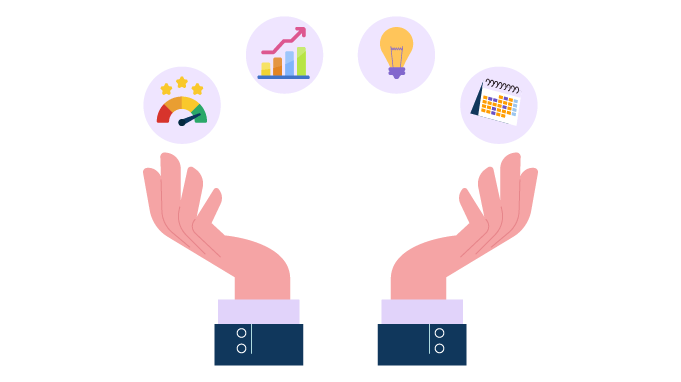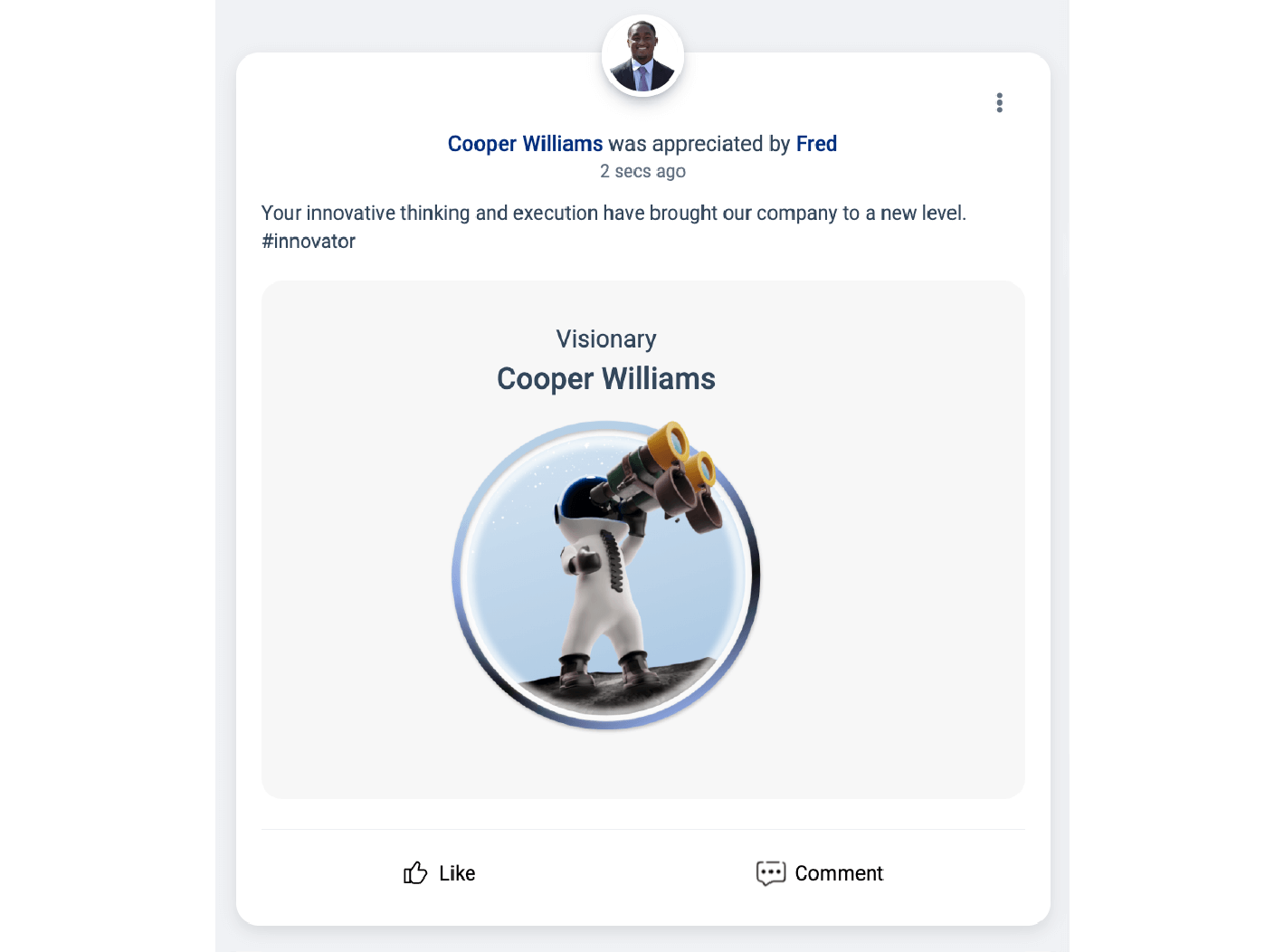Goal Setting For Employees: Meaning, Types, Examples and Challenges
In today's dynamic and competitive work environment, success is not a matter of chance; it's a result of clear direction and purpose. That's why goal setting for employees is super important to achieve organizational success.
When employees have specific goals to strive towards, it positively impacts their employee performance. It not only fuels motivation but also drives productivity and growth.
In this blog, we'll delve into the essence of effective goal setting, explore its various types, and provide real-world examples. The insights will help enhance your organization’s performance management and address the common challenges.
So, let's dive in and make goal-setting a tool that works for everyone.
Key Takeaways
- What is Employee Goal Setting?
- Looking at the Benefits of Setting Goals for Employees
- How to Set and Achieve SMART Goals?
- Exploring the Challenges of Goal Setting for Employees
- How to Align Goal Setting with Performance Management System?
What is Employee Goal Setting?

According to a study, employees who set goals are 3.6 times more likely to exhibit commitment to their organization.
Employee goal setting is the practice of establishing specific and measurable objectives for employees to work towards within a given timeframe. It involves creating a clear roadmap that connects employees' efforts with the organization's vision.
Effective employee goal setting often follows the SMART framework, ensuring that goals are Specific, Measurable, Attainable, Relevant, and Time-bound. This approach encourages employees to set realistic targets that align with organizational goals.
For instance, a marketing specialist is tasked with increasing social media engagement for the company. The goal might be to boost the company's LinkedIn followers by 20% over the next six months.
This clear and measurable goal gives the employee a set target and direction. It also helps the employer track the progress, which contributes to the overall success of the marketing team and the company.
Benefits of Setting Goals for Employees
Goal Setting for employees comes with many benefits that positively impact individuals and the organization. It provides a sense of direction to your employees to accomplish their objectives.
Let’s look at some of the benefits of Goal setting for Employees:
1. Enhance Employee Performance
Setting goals and objectives enhances employee performance by making them more accountable for their work. With a defined target in mind, employees can identify important activities and allocate their time and resources accordingly. This prevents them from getting sidetracked by tasks that are less important.
For instance, let's consider a marketing team tasked with launching a new product campaign. Without clear goals, team members might get bogged down in minor details.
However, if the team sets specific targets such as generating 100 leads within the first month, everyone has a common understanding of what needs to be achieved.
Furthermore, when employees know exactly what is expected of them, they are more likely to deliver high-quality work. This ultimately leads to enhanced employee performance and contributes to the overall success of the organization.
2. Facilitate Learning and Development
An organization's success relies on the collective knowledge and skills of its workforce. Therefore, it's imperative for organizations to foster a culture of continuous learning and development in the workplace.
This proactive approach helps employees to continuously acquire new skills and refine the existing ones. It strengthens the organization's ability to adapt and thrive.
Furthermore, investing in upskilling employees gives organizations a strategic advantage over competitors. They attract top talent, retain valuable employees, and foster a culture of innovation and creativity.
For example, a tech company that encourages employees to set goals related to mastering emerging technologies can position itself as a leader in the industry.
3. Motivate Employees
Goals provide employees with a sense of purpose and direction, which in turn boosts motivation. When employees are given the opportunity to set their own goals, they feel a stronger sense of ownership and accountability.
It instills a sense of achievement and drives them to keep pushing forward.
Consider a team working towards a common project deadline; the shared goal can motivate each member to contribute their best efforts to ensure success. As they actively pursue this objective, they become more invested and motivated towards their work.
4. Increase Employee Engagement
Goal setting boosts employee engagement by offering opportunities for personal as well as professional growth. When employees are involved in the goal-setting process, they feel empowered and valued, knowing that their input is considered in shaping the direction of their work.
Consider a scenario where an employee is discussing an upcoming project with its manager and the employee is allowed to express their preferences. This simple gesture can make employees feel valued.
Moreover, this collaborative approach encourages ongoing dialogue between employees and managers, making them feel engaged and invested in their work.
This heightened engagement can lead to improved job satisfaction, higher productivity, and a stronger commitment to the organization.
5. Improves Time Management
Employees with well-defined goals can manage their time efficiently by prioritizing work and preventing distractions.
Imagine an employee whose project deadline is two weeks away. With a well-defined goal in mind, they are compelled to break down the tasks, allocate time for each, and create a plan to meet the deadline. This process inherently encourages efficient time management.
Moreover, having a specific goal creates a sense of urgency. For instance, if a deadline for a crucial project is approaching, the task automatically becomes a priority.
Types of Goals for Employees

1. Performance Goals
Employee performance goals are short-term, action-oriented objectives that employees must achieve to fulfill their specific job responsibilities.
For instance, a marketing manager may be tasked to generate leads and land new clients, or a sales representative might have a monthly sales quota they need to fulfill.
These goals might be a benchmark against which their performance can be assessed and help employees focus on achieving the results.
2. Development Goals
Employee development goals refer to objectives and targets focused on an individual's overall professional growth within an organization. These goals are designed to empower employees to continually improve their performance and contribute more effectively to the organization.
For instance, an employee may want to enhance their technical proficiency by taking a course, or they may want to earn a degree to improve their expertise.
As an employer, you can provide them with the essential resources and financial support to assist them in reaching their developmental goals.
3. Collaboration Goals
Collaboration goals are all about getting better at working together, sharing ideas, and improving productivity to achieve shared objectives. Setting collaboration goals can foster a culture of teamwork and cooperation, which is vital in building a positive workplace environment.
As an employer, you can set collaboration goals by implementing regular meetings and strengthening cross-functional collaboration between departments.
For instance, the marketing department could work with the product development team to ensure the company’s offerings align with customer needs.
4. Time Management Goals
Setting time management goals can assist employees seeking to increase productivity and manage their workloads more effectively. It helps employees optimize their workdays by prioritizing tasks that need their utmost attention.
For instance, an employee might set a time management goal to reduce the time spent on non-essential email and social media activities during work hours. They could achieve this by scheduling specific times for checking emails and limiting social media use to breaks.
5. Innovation Goals
Innovation and creativity are vital in fueling growth and maintaining a competitive edge. Setting innovation goals can help employees develop new ideas, embrace new challenges, and think creatively. It assists organizations to stay ahead of the curve and remain relevant in the marketplace.
Examples of innovation goals could include solving problems uniquely, willingness to take risks, promoting fresh ideas, and maintaining a competitive edge through state-of-the-art products.
Employee Goal-Setting Examples

Setting clear and meaningful goals for employees is essential for the success of your organization. When done right, goal setting can improve employee performance, boost motivation, and foster professional development.
To assist you in setting the right goals for your employees, we've compiled a list of employee goal-setting examples.
Each example is outlined with how it meets the SMART goal criteria or the OKR (Objectives and Key Results) framework standard, depending on the scenario.
Example of Employee Performance Goals
Objective: Developing a Social Media Strategy for the next quarter.
Key Results:
- Post 5 social media posts per week.
- Increase the follower base from 5,000 to 10,000.
- Maintain an engagement rate of 10%.
This goal follows the OKR framework, focusing on the objective and key results. It outlines measurable actions that align with the larger goal of enhancing the company's social media presence.
Example of Time Management Goals
In order to showcase the difference between Poor Goals and SMART Goals, let’s consider these examples.
Poor Goal: Improve the work performance.
Now, let's analyze why this is a poor goal:
-
Not Specific: The goal lacks clarity. What aspect of work performance needs improvement? It doesn't provide clear guidance or a specific target.
-
Not Measurable: There's no way to measure progress or success. It's unclear how one would know when this goal has been achieved.
-
Not Achievable: It doesn't set realistic expectations or offer a plan to accomplish the improvement. It's too vague to take actionable steps.
-
Not Relevant: The goal doesn't specify why improving work performance is important or how it aligns with broader objectives.
-
Not Time-bound: It lacks a timeframe for achieving the improvement, making it easy to procrastinate or lose focus.
Now, let's transform this into a SMART goal.
SMART Goal: Increase the weekly sales by 15% within the next three months by proactively reaching out to at least 10 new leads each week and improving product knowledge through regular training sessions.
Let's break down why this is a SMART goal:
-
Specific: It clearly defines the area of improvement, which is increasing sales, and provides specific actions to achieve it.
-
Measurable: Progress can be tracked by monitoring the weekly sales figures. A 15% increase provides a clear target.
-
Achievable: It sets a challenging but attainable target by specifying the actions to take (reaching out to new leads and improving product knowledge).
-
Relevant: Increasing sales is relevant, as it directly impacts job performance and contributes to company goals.
-
Time-bound: It includes a clear timeframe - achieving the 15% increase within the next three months.
In contrast, the SMART goal is well-defined, quantifiable, and provides a clear roadmap for improvement, while the poor goal lacks these essential attributes and is vague in nature.
Example of Team Collaboration Goals
Objective: Foster Team Collaboration
Key Result:
- Organize monthly team-building activities or events.
- Encourage cross-departmental collaboration by initiating joint projects.
- Measure the team's overall satisfaction with collaborative efforts through surveys.
This goal follows the OKR framework. In this team-oriented objective, the employee aims to strengthen collaboration. Key results include proactive activities and feedback collection to gauge the impact of their efforts.
5 Tips To Facilitate Better Goal Setting For Employees
1. Set and Achieve SMART Goals

Setting goals without prior planning serves no purpose. That is why today’s organizations invest in the practice of SMART goal setting.
SMART goals facilitate better goal setting for employees by providing a structured and effective framework for setting objectives. SMART is an acronym that stands for:
Specific Goals
Specific goals are clear and well-defined. When employees have specific goals, they know exactly what is expected of them.
In order to set specific goals for your employees, you must clearly define what needs to be achieved and how. Ask these questions before setting goals for your employees:
- Why achieving this goal is important?
- Who is going to work on this goal?
- Which resources will it involve in achieving this goal?
Measurable Goals
Measurable goals provide a clear understanding of an employee’s progress. It tracks their performance and sees how close they are to achieving the goal.
As an employer, you can set measurable goals by keeping a record of how long your employees take to finish a task or meet a milestone. This will enable you to assess performance objectively during performance reviews.
Achievable Goals
Achievable goals are objectives that employees can realistically attain, given their resources and capabilities. When your goals are well-defined, your employees are more focused and determined to achieve them.
For instance, if an employee wants to acquire new skills or knowledge, an achievable goal for them could be "I will learn a new language by dedicating 30 minutes each day for six months." This approach ensures steady progress.
Furthermore, employers can help them achieve the goal by providing access to language learning resources, such as online courses or subscriptions to language learning platforms.
Relevant Goals
Relevant goals are aligned with an employee's role and the organization's objectives. It ensures that employees work on tasks and projects directly, contributing to the company's success.
Let's say you have an employee working in a customer support role. You want to set relevant goals for them:
- Relevant Goal 1 (Non-SMART): Learn to play the guitar.
This goal is irrelevant to the employee's job or the company's objectives. It may be a personal interest, but it doesn't contribute to their performance or the organization's success.
- Relevant Goal 2 (SMART): Improve response time for customer inquiries by 20% within the next three months by implementing efficient response templates and training.
This SMART goal is directly related to the employee's role in customer support. It is relevant because it aligns with the employee's efforts and the company's objectives.
Time-bound Goals
Time-bound goals are objectives that have a specific deadline or timeframe for completion. They set a clear endpoint for when the goal should be achieved, adding a sense of urgency and accountability to the goal-setting process.
Asking the marketing manager to complete the marketing campaign report by the end of this month is an example of a time-bound goal.
Recommended: Leadership SMART Goals - Tips and Examples
2. Strike a Balance between Employee Goals and Business Goals

Balancing employee goals with business goals is essential in making employees see how their work contributes to achieving organizational goals. This alignment creates a sense of purpose and direction for employees, making them more invested in achieving company goals.
Furthermore, allowing employees to have a say in setting their goals further enhances their commitment and likelihood of achieving them.
For instance, a marketing team's goal to increase online engagement and generate more leads through social media can be closely tied to the company's objective of expanding its digital marketing presence.
This alignment between personal and organizational goals ensures that the employees work towards a shared vision, leading to higher employee engagement and a sense of collective responsibility for the company's success.
3. Recognition of Achieving Performance Goals

Employee recognition is a powerful motivator that can significantly impact productivity, morale, and job satisfaction. Employees who receive frequent acknowledgment and appreciation for their efforts are more likely to perform better in their role.
Recognizing the efforts of your employees through public shout-outs, thank you notes, or tangible rewards such as bonuses or gift cards motivates them to do better at their jobs. It strengthens the bond between team members and fosters a culture of peer-to-peer recognition.
Moreover, virtual recognition platforms can facilitate regular employee recognition in the workplace. It can streamline the process and ensure that no outstanding performance goes unnoticed.
When employees feel that their efforts are recognized and celebrated, they become more engaged, committed, and take pride in their contributions.

Source: Vantage Rewards by Vantage Circle
4. Engage Employees To Participate in Goal Setting

Participation in goal setting is a powerful tool for fostering employee engagement and driving organizational success. When employees have a role in setting their goals, they take great care and responsibility to achieve them.
Employees who participate in goal setting gain a better understanding of what is expected of them. This clarity helps them prioritize their tasks and align their efforts with the company's objectives.
For instance, when a sales representative has a say in setting their own sales target and knows what's achievable, they are more likely to be engaged in the process, resulting in higher sales figures.
5. Align Goal setting with a Performance Management System

A Study by Gartner found that employee performance increased by 22% when companies added goal-setting to their performance management systems.
A Performance Management System (PMS) can be defined as a process that is designed to assess, measure, and enhance the performance of the workforce in the organization.
Aligning goal setting with a performance management system is crucial for ensuring that an organization's objectives are effectively met and that the workforce is motivated and equipped to contribute to these goals.
Organizations can use Performance Management Systems to simplify goals, accelerate performance reviews, and improve the performance appraisal process by making them feel more involved in the process.
Challenges of Setting Employee Goals

While the benefits of employee goal setting are crucial for workforce management, a number of challenges can prevent you from realizing the benefits. The challenges of setting employee goals can include:
1. Unclear Objectives
When objectives are unclear or vague, employees are left to interpret the goals on their own. This can lead to misalignment and inconsistency in their efforts as employees may not understand what’s expected of them.
Ambiguous goals create uncertainty about what success looks like and how it should be measured. Without specific, measurable targets, employees may struggle to understand the level of effort required or the desired outcome.
For example, if the goal is simply to "increase brand awareness," some employees may focus on social media campaigns, while others may prioritize traditional advertising methods.
Without clear metrics or benchmarks, it becomes challenging to evaluate whether their efforts are truly achieving the intended objective or not.
Moreover, unclear objectives can hinder collaboration and teamwork as it can lead to miscommunication or even counterproductive actions. Since, different team members can have different understandings of the goal.
2. Lack of Clarity
Even when the overall objective is clear, a lack of clarity in terms of specific tasks and deadlines can pose significant challenges for employees to achieve their goals.
Without these critical details, employees may feel lost or unsure about how to proceed, leading to confusion and inefficiencies. They may waste time and effort pursuing activities that are misaligned or ineffective.
For instance, without clear timeframes, employees may lack a sense of urgency leading to procrastination or missed opportunities.
Additionally, the absence of deadlines can make it challenging to coordinate efforts, particularly in cross-functional projects.
3. Unrealistic Expectations
Ambitious goals can inspire employees to push themselves and achieve remarkable results. However, when goals are set at an unattainable level, it can have the opposite effect. It can lead to demotivation, burnout, and a sense of failure.
For example, a software developer is tasked with completing a complex project in an unrealistically short timeframe. In order to complete the task they may find themselves working excessively long hours. This may potentially compromise the quality of work.
Additionally, assigning goals that require skills or knowledge that employees do not possess can also create unrealistic expectations.
For instance, asking a marketing professional to develop a complex software application is an unreasonable expectation. This may take a toll on the employee’s job satisfaction and overall well-being.
4. Insufficient Resources
Even when goals are well-defined and attainable, lack of resources can pose a significant obstacle for employees. Without the proper tools, funding, or support, achieving an objective can become an uphill battle.
If employees are not provided with adequate resources, they may find themselves unable to execute their plans effectively. This can lead to frustration, demotivation and potential failure.
For example, if an employee is expected to perform at a high level with outdated or inadequate tools, it can significantly hinder their productivity. They may struggle to make informed decisions or develop effective strategies in the long run, which may hamper organizational development.
5. No Method for Tracking Progress
Establishing clear mechanisms for monitoring and evaluating progress is essential for ensuring that employees stay on track and achieve their goals. It can also pose difficulties for employees to hold themselves accountable.
Furthermore, without a clear and structured method for progress tracking, it becomes hard for organizations to gauge whether goals are being achieved.
It also makes it challenging for companies to identify potential roadblocks or obstacles that an employee might be facing in achieving their goals.
Bottomline
In conclusion, employee goal setting is not just a mere management practice but a guiding force contributing significantly to organizational growth. From SMART goals to collaboration and recognition, it's a vital tool for growth.
Challenges, like unclear objectives and resource shortages, must be addressed in order to make goal-setting a powerful force for your organization's success. So, you better gear up and start setting goals for your employees that will help your organization soar to new heights!


















